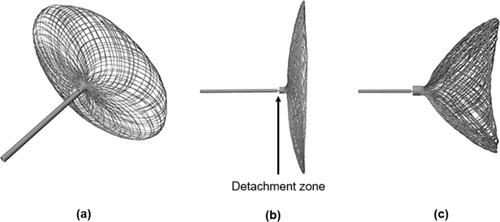Biomechanics and Modeling in Mechanobiology ( IF 3.5 ) Pub Date : 2024-04-08 , DOI: 10.1007/s10237-024-01829-3 Mengzhe Lyu , Ryo Torii , Ce Liang , Thomas W. Peach , Pervinder Bhogal , Levansri Makalanda , Qiaoqiao Li , Yiannis Ventikos , Duanduan Chen

|
Endovascular treatment has become the standard therapy for cerebral aneurysms, while the effective treatment for middle cerebral artery (MCA) bifurcation aneurysms remains a challenge. Current flow-diverting techniques with endovascular coils cover the aneurysm orifice as well as adjacent vessel branches, which may lead to branch occlusion. Novel endovascular flow disruptors, such as the Contour device (Cerus Endovascular), are of great potential to eliminate the risk of branch occlusion. However, there is a lack of valid comparison between novel flow disruptors and conventional (intraluminal) flow-diverters. In this study, two in silico MCA bifurcation aneurysm models were treated by specific Contour devices and flow-diverters using fast-deployment algorithms. Computational fluid dynamic simulations were used to examine the performance and efficiency of deployed devices. Hemodynamic parameters, including aneurysm inflow and wall shear stress, were compared among each Contour device, conventional flow-diverter, and untreated condition. Our results show that the placement of devices can effectively reduce the risk of aneurysm rupture, while the deployment of a Contour device causes more flow reduction than using flow-diverters (e.g. Silk Vista Baby). Besides, the Contour device presents the flow diversion capability of targeting the aneurysm neck without occluding the daughter vessel. In summary, the in silico aneurysm models presented in this study can serve as a powerful pre-planning tool for testing new treatment techniques, optimising device deployment, and predicting the performance in patient-specific aneurysm cases. Contour device is proved to be an effective treatment of MCA bifurcation aneurysms with less daughter vessel occlusion.
中文翻译:

大脑中动脉分叉动脉瘤的治疗:新型 Contour 装置和传统分流器的计算机比较
血管内治疗已成为脑动脉瘤的标准治疗方法,而大脑中动脉(MCA)分叉动脉瘤的有效治疗仍然是一个挑战。目前使用血管内线圈的血流转向技术覆盖了动脉瘤孔口以及邻近的血管分支,这可能导致分支闭塞。新型血管内血流干扰器,例如 Contour 装置(Cerus Endoangio),在消除分支闭塞风险方面具有巨大潜力。然而,新型流动干扰器和传统(腔内)流动转向器之间缺乏有效的比较。在这项研究中,两个计算机 MCA 分叉动脉瘤模型通过特定的 Contour 设备和分流器使用快速部署算法进行了治疗。计算流体动力学模拟用于检查所部署设备的性能和效率。对每个 Contour 装置、传统分流器和未治疗条件下的血流动力学参数(包括动脉瘤流入和壁剪切应力)进行了比较。我们的结果表明,放置装置可以有效降低动脉瘤破裂的风险,而部署 Contour 装置比使用分流器(例如 Silk Vista Baby)会导致更多的流量减少。此外,Contour装置具有针对动脉瘤颈部的血流导流能力,且不会闭塞子血管。总之,本研究中提出的计算机动脉瘤模型可以作为强大的预先规划工具,用于测试新的治疗技术、优化设备部署以及预测患者特定动脉瘤病例的表现。轮廓装置被证明是治疗MCA分叉动脉瘤的有效方法,且子血管闭塞较少。



























 京公网安备 11010802027423号
京公网安备 11010802027423号